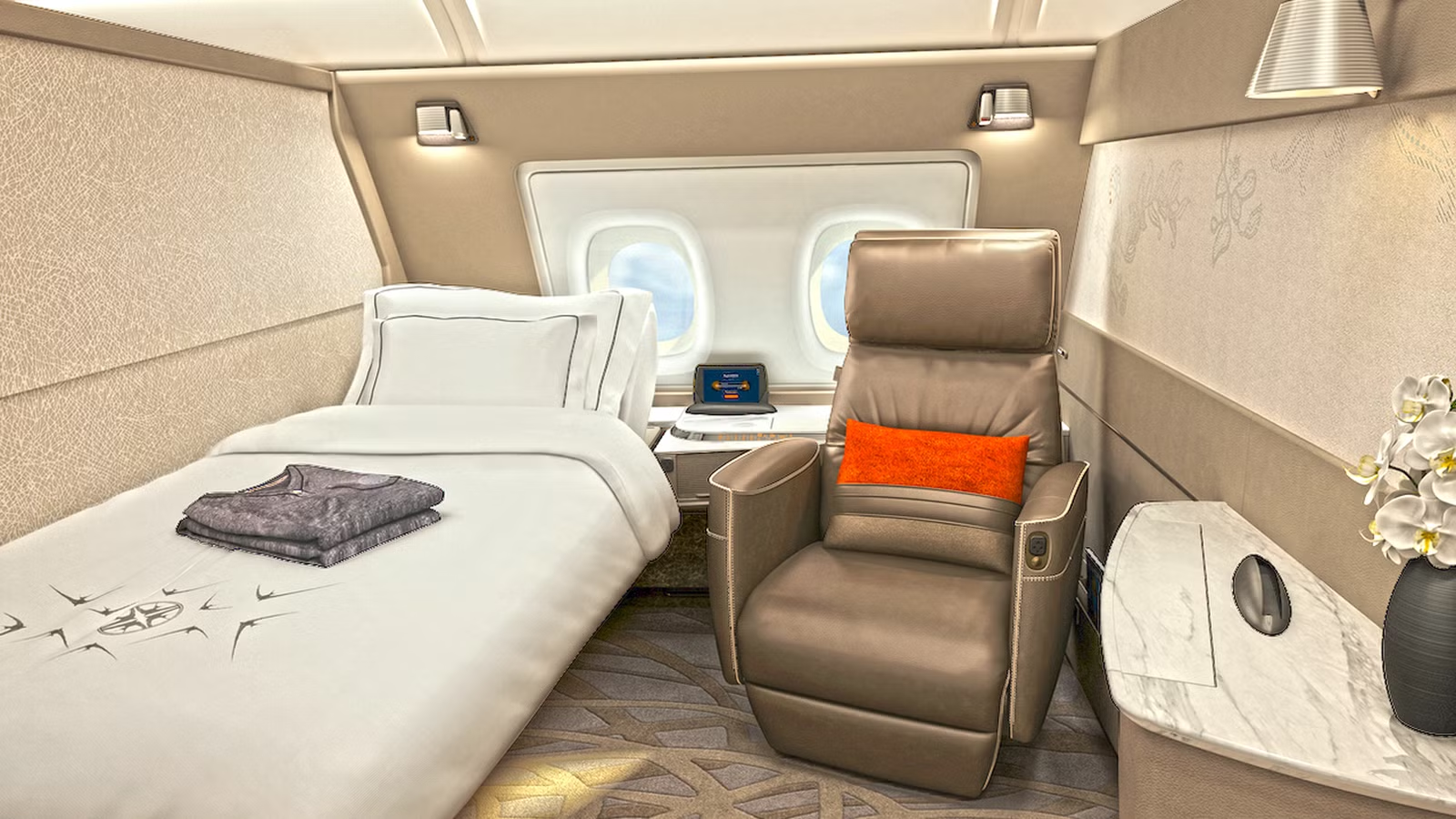This Airline Has The World’s Best First Class In 2025

Since the first passenger flights took off, flying has changed in almost every possible way. The experience onboard, the way passengers are served, and what airlines offer have all evolved with time. In the early days of air travel, there were no separate cabins, just one basic class. As more people began to fly and aircraft grew larger, airlines began introducing more refined seating and higher service standards, giving rise to what we now call first class.
By the 1930s, comfort had become a defining part of air travel. Many aircraft featured wide seats, tables, and even small lounge areas. Today, airlines are increasingly focusing on business and premium economy cabins. That being said, first class still remains a defining feature of commercial aviation. Several full-service carriers, such as Singapore Airlines, Etihad Airways, Emirates, British Airways, Lufthansa, etc., continue to offer it on select long-haul or flagship routes.
Singapore Airlines Named The World’s Best First Class Airline In 2025
Credit: Singapore Airlines
Indeed, seating and first class offerings gradually improved during the 1980s and 1990s. One of the most significant features we now associate with premium cabins is the flat bed, which first appeared in first class during the mid-1990s. Notably, British Airways was among the first airlines to install these to distinguish its product from business class. In some ways, this was a return to what early air travel had already offered, as aircraft in the 1930s often featured beds or reclining seats for long journeys.
Since then, first class has continued to evolve. The introduction of widebody aircraft such as the Boeing 747 and later the Airbus A380 gave airlines the opportunity to design more private and luxurious cabins. Many carriers now feature enclosed suites, walk-up bars, and dedicated social spaces. Etihad Airways, for instance, has introduced The Residence, a three-room suite with a living area, bedroom, and shower (which is available exclusively on its A380s). Emirates also offers fully enclosed first class suites with sliding doors.
Singapore Airlines similarly offers one of the most luxurious first class experiences in the world. The airline provides two premium first class options: the exclusive Suites on its A380 and a more traditional First Class on the Boeing 777. The A380 Suites feature a private cabin with a large swivel chair and a separate bed, while the 777 offers a fully flat bed within an enclosed personal space. In fact, the airline was named the World’s Best First Class Airline at the 2025 SKYTRAX World Airline Awards, and also won titles for Best First Class Onboard Catering and Best First Class Airline Seat for its A380 Suites.
When Singapore Airlines Redefined First Class With The Launch Of Its Suites
Credit: Singapore Airlines
Notably, Singapore Airlines was one of the first carriers to offer a true first class service. In fact, it was the first airline to introduce the Suites concept in 2007. The product was created to sit above traditional first class and was designed to set a new benchmark for luxury air travel. The suites were installed on the airline’s original batch of 19 Airbus A380s, which were later retired from service in March 2020 following the decline in global passenger demand during the COVID-19 pandemic.
Singapore Airlines had initially planned to launch its suites in April 2006. However, production delays postponed the A380 program, and the first aircraft delivery was pushed from late 2006 to October 2007, around 18 months later than planned. The unveiling of the suites coincided with the delivery of the first double-decker aircraft from Toulouse. As reported by Mainly Miles, at the launch, then-CEO Chew Choon Seng described the product as “a class beyond First,” and added, “From today, there is a new queen of the skies for air travel.”
At the time, Singapore Airlines, in a statement, said, “While the generous floor space of the A380 gave us many intriguing design options, we’ve developed our cabin interior with feedback from our customers and frequent flyers in mind. Though having bars, showers, and other such facilities sounds interesting, our research showed that what customers really want is personal space, comfort, and privacy. We chose to give the space to customers, especially in the premium cabins, instead of locking it away in gimmicks that may only be briefly used by some passengers on a flight.”
A Look Back At Singapore Airlines’ First Generation Of A380 Suites
Credit: Singapore Airlines
The first A380s operated by Singapore Airlines had a total of 12 suites on the main deck. Each suite featured a fully adjustable leather seat and a separate bed with a full-size mattress. It was designed by French yacht designer Jean-Jacques Coste and manufactured by Japan’s JAMCO and Aero Seats of France. Indeed, it was unlike anything passengers had seen before; it offered a new level of privacy and space.
Each suite had an 87.5-centimeter-wide leather seat and a 1.98-meter bed. Passengers traveling together could book adjoining Suites, 1A and 2A or 1F and 2F, which could be combined to form a double bed. The Suites also featured one of the most advanced entertainment systems at the time, with a 23-inch inflight entertainment (IFE) screen and multiple charging points. The product first entered service on two charity flights between Singapore and Sydney on October 25 and 26, 2007.
Regular daily service on the Singapore– Sydney route began on October 28. Later, as more A380s joined the fleet, the Suites were also introduced on flights to London and Tokyo. By March 2020, when the original A380s were retired, these Suites were still in use on select routes, including routes to Auckland, Beijing, Delhi, Frankfurt, London, New York, and Sydney.
Over the years, they also appeared on flights to Melbourne, Shanghai, Los Angeles, Mumbai, Osaka, and even Bangkok during the Songkran season. Interestingly, the suite’s cabin had three dedicated crew members for just 12 passengers. According to the airline, cabin crew assigned to the Suites completed an additional day of training, including learning how to set up the bed within three minutes.
The 2017 Redesign: Six New Suites And A Modern Take On Luxury
Credit: Singapore Airlines
Furthermore, later in 2017, following four years of development and an investment of $850 million, Singapore Airlines introduced a completely redesigned cabin for its Airbus A380s. It was the airline’s first major overhaul in a decade. Notably, the highlight was the new first class, which replaced the previous 12 suites with just six. These were manufactured by Zodiac Aerospace and relocated to the forward upper deck.
Currently, the redesigned layout features a central aisle with three suites on each side: A Suites on the left and F Suites on the right. Each suite includes a large leather chair that swivels 135-270 degrees via electronic controls, and a separate bed positioned perpendicular to the windows. Passengers traveling together can book adjoining suites, either 1A and 2A or 1F and 2F, where the dividing wall can be lowered to create a double bed. Additionally, each suite features a 32-inch IFE screen, multiple storage compartments, and ample personal space.
Besides, the cabin includes two bathrooms for just six passengers. One of them features a large vanity area with lighted mirrors and ample counter space, while the other offers a similar design without the vanity section. Both are spacious and equipped with premium fittings. Beyond the cabin design, the airline’s service standards also remain a key part of the experience. Singapore Airlines continues to work with international chefs to create its in-flight menus and offer passengers alternative options if preferred.
Where Singapore Airlines’ A380s Fly Today
Credit: Shutterstock
According to ch-aviation data, Singapore Airlines currently operates a fleet of 12 Airbus A380s, nine of which are in active service and three are undergoing maintenance. All 12 aircraft feature the latest six-suite first class configuration introduced in 2017. This year, the airline has scheduled more than 4,900 A380 flights, according to aviation analytics provider Cirium.
As we know, Singapore Airlines has one of the most extensive route networks in the world, serving more than 120 destinations across five continents. Indeed, the double-deckers have been part of its fleet for almost 18 years and are mainly used on high-demand routes. Australia is one of the airline’s most important markets. In fact, the busiest route for the A380 is Singapore to Sydney, with over 700 one-way flights scheduled this year.
Singapore Airlines Airbus A380 Flights In 2025
Route
Total Flights (one-way)
Notes
Singapore–Sydney
702
Year-round;
Twice daily (except May, when the airline
offered one daily departure)
Singapore–London Heathrow
673
Year-round;
Twice daily (except February & March, when
the airline offered one daily departure)
Singapore–Frankfurt
345
Year-round;
One daily departure (except in January, the
airline deployed the A380 until January 14)
Singapore–Mumbai
299
One daily departure since February
Singapore–Delhi
298
One daily departure (reduced frequency in June & July)
Singapore–Shanghai
107
Only operated in January (17), March (20), June (8), July (31), August (31)
Singapore–Tokyo Narita
31
Offered one daily departure in May
Singapore–Hong Kong
30
Offered 16 flights in January and 14 in March
The airline usually operates around four daily flights on this route, using both the A380 and Boeing 777-300ER. Two of these are A380 services for most of the year, although only one daily flight operated in May. Singapore Airlines will also be the first international carrier to operate from Sydney’s new Western Sydney International Airport (WSI) when it opens in late 2026. The airline hasn’t confirmed the schedule or aircraft type, but the airport can handle the A380.
Furthermore, London is another key market, with more than 670 one-way A380 flights scheduled. The airline usually offers two daily services, although there were temporary reductions to one in February and March. Besides, other destinations that see the A380 include Frankfurt, Mumbai, Delhi, Shanghai, Tokyo Narita, and Hong Kong, which is the shortest A380 route in the network.
Loved But Aging: What’s Next For Singapore Airlines’ A380
Credit: Shutterstock
Indeed, the A380 remains a key part of Singapore Airlines’ fleet and continues to be highly valued by passengers. As the airline’s Regional Vice President for Europe, Joey Seow, told Simple Flying a couple of months back, “The A380 is a much-loved plane by many of our customers. This is in part because the fuselage is the widest in the industry today. We can do more through the real estate of the A380. For example, in our Suites, we have a separate bed with a separate chair, and that’s all, primarily because of the space that we have on that plane. So, consequently, it is much loved, but at the same time, it is also an aging plane.”
As previously mentioned, Singapore Airlines received its first A380 in 2007 and has since taken delivery of 24 aircraft; half of those have already been retired. According to ch-aviation data, the airline’s active A380 fleet currently averages around 11.5 years of age.
There have been rumors suggesting that the airline may start withdrawing the type next year, but Cirium data indicates otherwise. The A380 remains scheduled on several of the airline’s key routes well into September 2026. For now, the aircraft continues to serve as its flagship and offer passengers one of the most luxurious flying experiences in commercial aviation.





